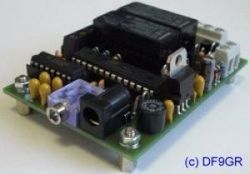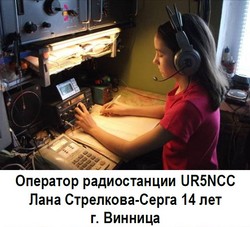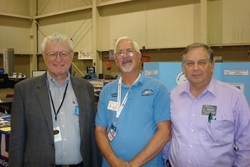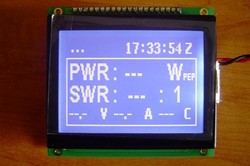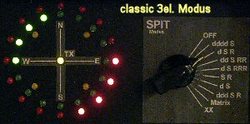 November 20, 2013 Editor: Ward Silver, NØAX | |||||||||
IN THIS ISSUE
NEW HF OPERATORS - THINGS TO DO If you have a modest station, would like to put some DX in your log, and can handle a key or paddle, the CQ World Wide DX CW Contest is the only game in town this weekend. WW CW is usually on Thanksgiving weekend but due to the first of November falling on Friday this year, the contest comes before the holiday. If contesting on a holiday weekend (in the U.S.) cramps your style, this is the once-every-few-years opportunity to have your turkey and contest, too! BULLETINS Received from Jojo DU1VHF, NTS Chairman and CFO for the Philippine Anateur Radio Association - please read and heed. "The much-awaited CQ WW CW Contest is nigh and everyone is chomping at the bit. However, here in the Philippines, our enthusiasm is a bit tempered by the recent events of a catastrophic typhoon which took thousands of lives and destroyed much of a region in the Southeastern portion of the country. As such, hams in the Philippines are using the frequencies 7.095, 7.119 and 7.151 MHz for emergency operations. We hope that this could be given notice in order that QRM might be minimized and not hinder emergency operations." The subject is also addressed in this issue's Conversation section. BUSTED QSOS Perhaps characterizing the previous W5 win in CQ WW SSB as "never" was a bit strong! Rick K3OO recalls Jeff N5TJ winning SOHP in that contest around 1993 and coming in second with both scores in the range of 6 million points. Jeff recalls there being a couple of other wins from the fifth district back in the 1960s, as well. CONTEST SUMMARY Complete information for all contests follows the Conversation section 23-24 November
30-31 November
Those awho asked for Single-Op Unlimited (SOU) categories in all ARRL contests are getting their wish. Beginning with the RTTY Roundup in January, SOU will be part of all ARRL HF contests. Watch for each contest's announcement as the details are worked out to add the category. The major contest logging software packages already do or will support SOU in RTTY Roundup but be sure you have upgraded to the latest version that supports submitting the log as an SOU entry.
One part of the special activities for the 80th Sweepstakes is recognizing the octogenarian contesters among us - and there are more than you might expect. If you know one who made any QSOs in either weekend of Sweepstakes, make sure the ARRL knows about it at contests@arrl.org. After the contest, the soapbox and stories received will be totaled up on the Sweepstakes website. The honoree can have been licensed for a year, a decade, or longer - just be sure we get a chance to tip the Sweepstakes cap in their direction! While you're there, don't forget to download your 80th Sweepstakes certificate and stickers. A tip from the Volunteer Examiner community alerting us to be sure the study guides of our students are up to date. Hand-me-down copies and out-of-date books in libraries and stores can cause a lot of problems. The question pools are updated every four years. The dates for which the material is valid are usually printed on the cover - why not check what's available in your library and offer to update it if necessary? Here's another anniversary - the WLS tower in Illinois has reached the advanced age of 75 years as described in this story from Radio World. Given the number of ice storms, such longevity is pretty amazing! (Thanks, Eric W3DQ)
Rotator control has another option with the products from Easy-Rotor-Control. The controllers are standalone microprocessor-based products available with either RS-232 or USB interfaces. You can buy them as a kit or completely assembled. These interface with most rotators and look handy for remote control and automated station building. With the invaluable help of Terry AB5K, Jose CT1BOH/CR3E reports that the algorithm behind the dynamic error-free RBN-Skimmer is now in place at selected AR cluster nodes and the RBN AR-Cluster node found at arcluster.reversebeacon.net, port 7000. This is a great tool for to confirm that the spotted calls are OK and not busted or fake, and may also prevent some of the busted call pile-ups that generate a lot of dupes for running stations. This system tries to identify and flag busted spots, non-existent calls spotted on a particular frequency, and spots with unstable frequencies. The tool might also encourage Assisted users to confirm the call before calling blind - what a concept! Each spot sent out by an AR cluster or RBN cluster now has a spot quality tag next to it in the comment field to indicate whether the call sign has been judged valid or not and why. Jose shows how to use this feature in a series of online images (substitute 2, 3, 4, etc for the number preceding ".png" in the URL to progress through all 8 images.) Part 1 of an excellent article about amateur participation in the International Geophysical Year (1957-1958) was recently published by Phil K9PL in the K9YA Telegraph. Amateurs were involved in a number of programs that supported scientific research around the world and still are, on occasion. As long as we're covering history, check out this IEEE story about the four incarnations of Britain's royal research vessel, Discovery. Your editor just received a renewal notice for his "Spot the Station" NASA alerting service to when the International Space Station will be visible. You can sign up for this free service and never miss another pass! Web Site of the Week - Proceedings for the recent Pacific Northwest VHF Conference are available online instead of publishing a CD or printed book. Presentations on expeditions are available by W7GJ and K5QE along with noise measurement by N6OCN and solid-state amplifiers by W6PQL. (Thanks, PNW VHF Society Webmaster, Barry K7BWH) WORD TO THE WISE
The motto of January's United Teenager Contest is: "Participation is more important than the victory, and friendship is worth more than prizes." That link includes numerous enjoyable photos of young operators having fun in the contest. Rules in English are at the bottom of the page. Here is an interesting "cross-implementation" of a regular internal combustion engine that uses electronic components. A tutorial for a very simple "one-cylinder" equivalent solenoid engine is also available. Not quite the DXCC List set to Gilbert & Sullivan, but this geographical aria will do. (Thanks, Norm W9VQ) ARRL Contest Branch Manager, Mike N1TA reports that the Extended Version of the results article for the August UHF Contest by K9JK is now online. CQ World Wide Director, Randy K5ZD reports a very small error in the raw score calculations for CQ WW SSB. Updated scores are now online. Claimed scores for the 2013 Worked All Germany Contest are now published on the WAG website. Please check whether you are grouped into the correct category and whether your score differs much from what your software calculated. "We hope to have the results ready at the end of the year, but log checking will be a bigger workload than usual as we have a record number of >1900 logs." (Thanks, WAG Contest Manager, Chris DL8MBS)
Extending the how-remote-is-remote list, Hal W1NN operated his home station in Medina, OH in this year's CW Sweepstakes remotely from Tokyo, Japan. Bob K8GL notes that Google Earth reports the distance as 6525 miles city to city. That's quite a long keyer cable! We seemed to have reached the point at which there is sufficient network bandwidth to operate stations located nearly anywhere from nearly anywhere. Don't forget that local regulations apply and that contest and award rules require you to conduct the operation and submit the entry based on the location of the station. OPERATING TIP With CQ WW CW upon us, the subject of cut numbers ("N" for "9", "A" for "1", etc.) will no doubt come up. While K9NW refers to ARRL DX CW exchanges here, there is plenty that applies to WW and other contests. Every time there's a "number" contest, the topic of cut numbers comes up, i.e., what you should log, etc. You can rest assured that the log checking team operates the contest and they know what this stuff means - and they have software that also knows what this stuff means. The easiest way to deal with cut numbers is to just learn them. There are only a few that are in regular use. You don't have to use them, you don't even have to like them. But you might as well accept that they're going to be used by others. No need to over-think this. Following some recent discussion about the performance of UHF-series connectors at VHF and UHF, Larry WØQE made some VNA measurements and has published them online. He went further to determine how to compensate the observed impedance mismatches in the 500 MHz region verified them using the SimSmith software by AE6TY.
John N2NC reminds us of the nice weekly report available from NOAA's Space Weather Prediction Center, "The Preliminary Report and Forecast of Solar Geophysical Data, called "The Weekly", summarizes a week of space weather activity and provides outlooks for solar and geophysical activity for the next solar rotation -- 27 days." And the price is certainly right! Over the summer, Jim K9YC did extensive modeling (NEC) of vertical quarter-wave and vertical dipole antennas, comparing performance on the ground and at typical roof heights. A report on that work is available online in the form of PDF slides from the PowerPoint presentation Jim gave at the Pacificon convention in October. He notes in summary, "for all vertical antenna types and almost all soil quality, roof mounting outperforms ground mounting. The advantage of roof mounting is greatest for the poorest soil, varying from as much as 8 dB for very poor soil to a dB or so for extremely good soil." The return of the vacuum tube is making some news lately. While your stock of 807s and UV-201 is unlikely to suddenly fund your retirement, "field-emission devices" have their strong points and a hybrid of semiconductor and tube technology is attractive in certain applications. (Thanks, Art WØKG) Roger K8RI notes, "when you see a white insulator in connectors, it is often High Density Polyethylene (HDPE) and not Teflon. HDPE has very poor thermal characteristics and has a hot oil-like smell when heated." To test for HDPE, "Put the tip of a small, hot, soldering iron on Teflon and nothing happens, but on HDPE it quickly leaves a dent. Held side by side the Teflon is a whiter white while the HDPE is slightly darker and very smooth, almost slippery, to the touch." Dan AC6LA has released TLDetails to to plot Velocity Factor (VF) vs frequency for any of about a hundred different types of feed lines, including Bury-Flex. Sample plots show that the higher the loss, the more the VF drops off at lower frequencies. Jim K9YC notes that before cutting stubs for filters or matching, "determine VF for the coax you're using and don't count on the published value being right. Most solid dielectric coax is close to 0.66 and most foam is in the range of 0.75 - 0.85."
Solid-state amp builders may be interested in the microprocessor-based amplifer controller from VK4DD Software is available for modification, too. The controller uses a PIC microprocessor and has a serial-interface LCD display. There are several other great projects on the site, as well. (Thanks Don K9AQ) This "Rarely Asked Questions" article from Analog Devices lists quite a number of online design tools and their associated support communities. These are useful to amateurs and professionals alike! Matt KM5VI relays the important point about taking time to confirm the polarity of baluns in arrays. It is not unknown for two baluns from the same manufacturer with identical part numbers wired with the load side connections internally reversed with respect to the casing of the unit. A reversed connection would greatly alter the antenna's performance.
Technical Web Site of the Week - Andrè DF9OX reports that "I am using the spitfire array now for 10 years on 80 meters, with a single center tower and 4 directional wires, switched as director/reflector. The array is ok, giving some dB gain, f/s and f/b mostly OK" He notes that the performance is a bit below a 4-square, but likes the performance of this wire array. Peter DF3KV has provided an online description of the array, which will be updated as the array is used this winter. Sweepstakes Abroad What bombastic pageant A grand chorus sings the exchange Voices great and small I wonder at the multitude In listening to busy contests from other continents, I have often wondered what our truly large domestic contests sound like from far away. Sweepstakes doesn't stop at the North American continental shelf, of course, and I'm sure our friends around the world chafe a bit during these band-filling exercises. Fortunately for all, the "other" bands and modes are available if one is willing to make use of them. Our Philippine friends need a bit of breathing room as described in the Bulletin section at the beginning of this newsletter. While their published emergency communications frequencies of 7.095, 7.119, and 7.151 MHz are not right in the thick of the CW action during the CQ World Wide CW contest but 'phone and digital operators displaced by the high activity on CW might find themselves unintentionally interfering with operations on those frequencies. This all comes about because of the unique nature of the shortwave bands that makes them planetary water holes at times. Most of the time, it's a feature, but when signals from the antipodes interfere with relief efforts, it's a bug. FCC rules are clear in that intentionally interfering with someone else's communications is not allowed but the FCC rules stop (mostly) at the border. That's where basic good operating practices have to be employed. Always. Not just on contest weekends.
Amateur radio is unique among the radio services in its flexibility. Let's put that to work. On the transmitting end, listen first and make sure you're not clobbering somebody before calling CQ, especially operating split from outside the US and listening in the US bands. Be willing to slide up a little or down a little as the need arises. And make sure your signal is clean by backing off the Mic Gain or compression and slowing your keying waveform rise and fall times. Over on the receiving end, be prepared. If you have a regularly scheduled activity such as a net or a schedule, have a "plan B" with an alternate frequency, time, or even mode. Take a look at online calendars that list upcoming activities such as DXpeditions, contests, and special events. Know how to use your receiver to minimize overloading and noise - turn off preamps and noise blankers, for example. Back off the RF Gain just as you expect the "other guy" to back off the Mic Gain. You might be surprised at how much cleaner the band sounds under all circumstances. Regardless of our best efforts, there will be QRM at times but don't let it get to you. I may be frustrated that a festival at my favorite park brings the crowds but I know next weekend they'll be gone and calm will return. In turn, I can also recognize that my own gatherings and games may crowd my neighbors a bit as well. But on the air I am willing to adjust, use my know-how, and make the most of things, even in the midst of bombastic pageants near and far. 20 November through 3 December 2013 An expanded, downloadable version of QST's Contest Corral in PDF format is available. Check the sponsor's Web site for information on operating time restrictions and other instructions. HF CONTESTS CQ World Wide CW Contest--CW, from Nov 23, 0000Z to Nov 24, 2359Z. Bands (MHz): 1.8-28. Exchange: RST and CQ zone. Logs due: Nov 29. Rules SKCC Straight Key Sprint--CW, from Nov 27, 0000Z to Nov 27, 0200Z. Bands (MHz): 1.8-28, 50, Monthly on the fourth Wednesday UTC. Exchange: RST, S/P/C, name, SKCC nr or power. Logs due: 5 days. Rules Top Band Sprint--Phone,CW, from Nov 28, 0000Z to Nov 28, 0600Z. Bands (MHz): 1.8. Exchange: RST, S/P/C, ARCI number or Power. Logs due: 14 days. Rules Full Day of Hell--Digital, from Nov 30, 0000Z to Nov 30, 2359Z. Bands (MHz): 1.8-28. Exchange: RST, S/P/C, Feld-Hell mbr nr, 4-char grid square. Logs due: 7 days. Rules SARL Digital Contest--Digital, from Dec 1, 1300Z to Dec 1, 1600Z. Bands (MHz): 3.5-14. Exchange: RST and serial. Logs due: 7 days. Rules VHF+ CONTESTS SKCC Straight Key Sprint--CW, from Nov 27, 0000Z to Nov 27, 0200Z. Bands (MHz): 1.8-28, 50, Monthly on the fourth Wednesday UTC. Exchange: RST, S/P/C, name, SKCC nr or power. Logs due: 5 days. Rules LOG DUE DATES 20 November through 3 December 2013
ARRL Information Click here to advertise in this newsletter, space subject to availability. Your One-Stop Resource for Amateur Radio News and Information ARRL membership includes QST, Amateur Radio's most popular and informative journal, delivered to your mailbox each month. Subscribe to NCJ - the National Contest Journal. Published bimonthly, features articles by top contesters, letters, hints, statistics, scores, NA Sprint and QSO Parties. Subscribe to QEX - A Forum for Communications Experimenters. Published bimonthly, features technical articles, construction projects, columns and other items of interest to radio amateurs and communications professionals. Free of charge to ARRL members: Subscribe to The ARRL Letter (weekly digest of news and information), the ARES E-Letter (monthly public service and emergency communications news), Division and Section news -- and much more! ARRL offers a wide array of products to enhance your enjoyment of Amateur Radio. Visit the site often for new publications, specials and sales. Donate to the fund of your choice -- support programs not funded by member dues! Reprint permission can be obtained by sending email to permission@arrl.org with a description of the material and the reprint publication. ACKNOWLEDGEMENTS ARRL Contest Update wishes to acknowledge information from WA7BNM's Contest Calendar and SM3CER's Contest Calendar. | |||||||||

